When you are looking for the perfect fish to join your community, a brilliant option would be the Clown Tang, which also goes by the name of Striped Surgeonfish, Clown Surgeonfish, Lined Surgeonfish, or Blue-banded Surgeonfish, as well as the scientific name of Acanthurus lineatus.
This remarkable fish is covered in bright, horizontal striping that encompass their bright yellow or orange bodies, accompanied by large peduncle spines. They are a member of the Tang family, or Surgeonfish family, with their natural habitat being the waters of Fiji, the Maldives, and New Caledonia.
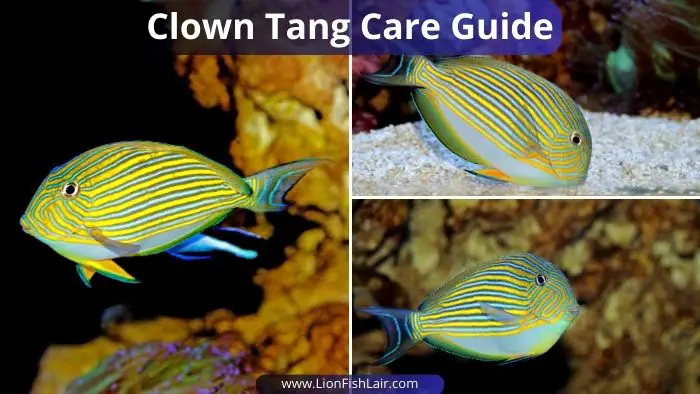
Despite being beautiful and entertaining fish, they are very hard to keep, and require you to have plenty of experience in keeping saltwater fish of a similar size with similar requirements. The reason why they are hard to keep is that they are very aggressive fish, as well as being non-hardy, meaning they will pick up diseases easily if their tank requirements have not been met.
Oh, and their tank requirements are very specific and must be monitored constantly, but more about that later. The last reason for clown tangs being hard to keep is that they are big fish, requiring a large fish tank, which, as you probably know, are extremely difficult to establish and maintain.
Now, let's dive into our guide on how you can keep a healthy and happy clown tang!
Clown Tang Overview and General Information
Here is an overview/summary of the clown tang as well as the topics that are covered in this clown tang guide:
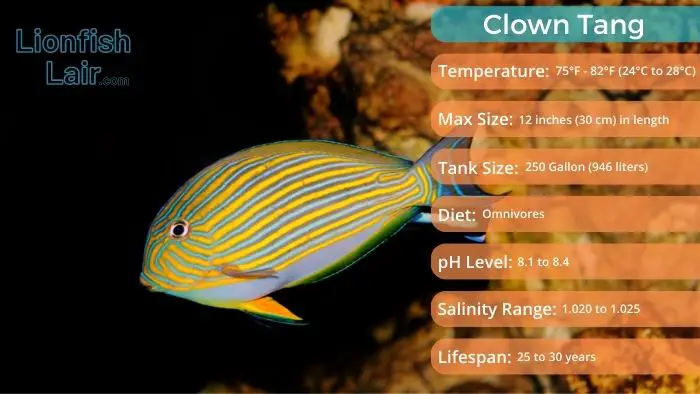
- Other names: Striped Surgeonfish, Clown Surgeonfish, Lined Surgeonfish, and Blue-banded Surgeonfish.
- Scientific name: Acanthurus lineatus.
- Temperature: 75 - 82°F (24 to 28°C).
- Diet: Clown tangs are omnivores and will require a balanced diet of fish and meats, with vegetables and plant matter.
- pH level: 8.1 to 8.4.
- Maximum size: 12 inches (30 cm) in length.
- Minimum tank size: 250 Gallon (946 liters).
- Temperament: Aggressive.
- Coloration and pattern: Yellow body paired with light blue and dark blue stripes.
- Care level: Moderate to difficult.
- Reef compatibility: Reef safe.
- Lifespan: Between 25 and 30 years.
Clown tangs are brilliant fish, however, as mentioned previously, they are not compatible with beginner hobbyists and require a large tank to swim around happily and live a healthy life.
Clown Tang Behavior and Appearance
It is important to know the size, behavioral tendencies, and personality of your desired fish before making the all-important decision to acquire one.
Behavior and Personality
Tangs as a species have somewhat of a reputation for perhaps not being the friendliest of fish especially with one another, and the clowns are no different, notorious for being one of the more aggressive types of Tangs.
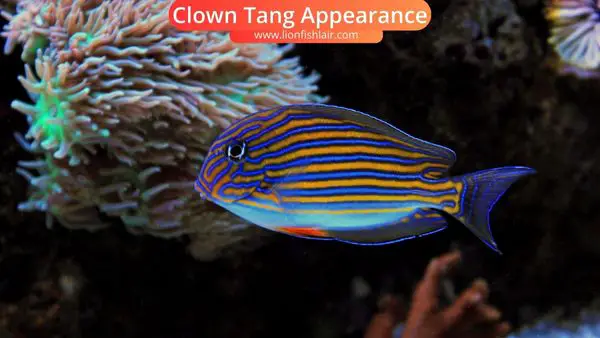
It is always a good idea with aggressive Tangs to keep them singularly, they tend to be happier alone, and keeping them away from other types of Tangs sharing similar shapes and sizes would also be a smart idea. You will find as you venture further down your hobbyist journey having a “tank bully” is kind of an inevitability, and the Clown Tang will usually become just that, even if they are smaller than the average adult-sized fish.
Much like other Tangs, Clown Tangs have a sharp and often venomous spine running along both sides of the caudal fin, which is typically used by them to defend themselves and their territory – so be careful when handling them, and look out for, and avoid touching them, and especially this fin! The venom from their spine can land you in all sorts of trouble, so, again, be very careful when placing your hands in their tank.
Appearance and Size
The reasons for the Clown Tangs having such distinctive, almost disc-shaped bodies are because of the dorsal and anal fins being much larger in these types of Tangs. When the fins are at full extension, the height of the fish measures almost the same as the length of them.

Clown Tangs are definitely not a small fish, growing to around 15 inches (40 cm) in length when an adult, this means that it is incredibly important to keep them in a large and suitably sized tank/aquarium. They also require plenty of spaces to hide, but also enjoy swimming around and will likely occupy all areas of your tank.
Clown Tang Tank Setup
Now that we have dived into the appearance, personality, and hobbyist compatibility, it makes sense to take a look at their tank setup and requirements.
Tank Size
As we know, clown tangs are big fish and can grow to incredibly large sizes, which is why they require such a big tank size. The minimum tank size for clown tangs should be 250 gallons (949 liters), this allows them to move around freely and have enough space to explore. Additionally, it will help smaller fish in your tank discover hiding spots and places to rest when your clown tang is looking for prey.
The graphic below displays the classic tank size you will need to keep a clown tang happy and healthy, which is 250 gallons, as well as the dimensions for this size aquarium (width, length, and height):
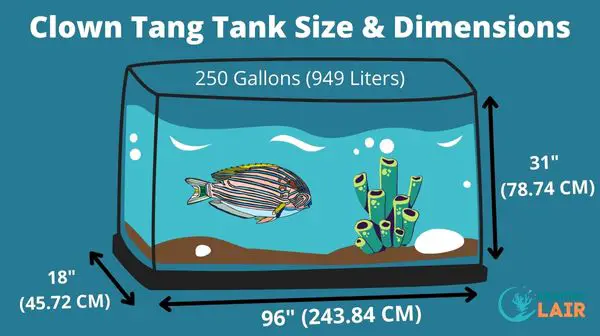
Temperature and pH Level
Clown tangs are tropical saltwater fish that require a temperature range of 75 - 82°F (24 to 28°C). They also need a pH level ranging between 8.1 and 8.4, a water hardness between 8 to 12, and a salinity 1.020-1.025.
Below is a graphic showcasing the general tank requirements for a clown tang - including the temperature range, ideal pH level, salinity, and water hardness:

Acclimitization
In terms of acclimatization, you will need to place the fish in a bucket and then drip acclimate for 1 hour (60 minutes) at a rate of 3 drips per second, which will then bring the Clown Tangs water parameters in line with your tanks.
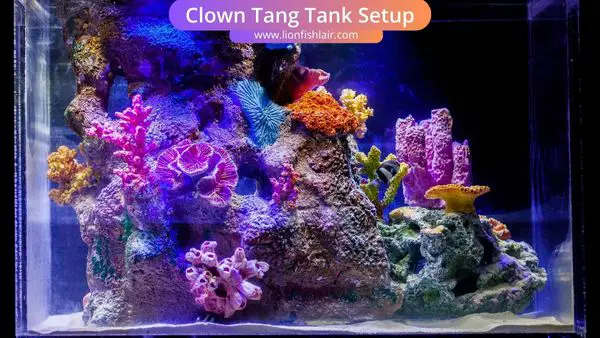
After the Tang has been acclimated, gather the fish with a net and place it gently into your tank, it is important to not mix any of the water the fish came in with into your own tank water! The lid to your tank must be on tightly and securely, this fish has been known to jump, especially when initially introduced to a brand-new environment.
Hardiness
Unfortunately, much like their Purple Tang counterparts, clown tangs are prone to disease, meaning that it is incredibly important to provide your fish with the right diet, accompanied by a clean, and well looked after tank. The typical diseases include Ich (Ick) and HLLE (Head & Lateral Line Erosion).
Both the water quality and also the stress level of your clown tang will play the biggest factors in whether or not they pick up diseases or not. So, ensure that you follow our guide on setting up their tank whilst hitting all of the requirements as well as changing the aquarium water by 15% to 20% every week to give them the best chance of living disease and parasite-free.
As you probably know - stress plays a tremendous role in the healthiness of your fish, especially when it comes to clown tangs. As you will find out from the seciton below, clown tangs do not play well with other fish, so, make sure that they have the right tank mates and also tank size to reduce stress levels.
Fish Compatibility - Clown Tang Tank Mates
Clown Tangs certainly thrive as individuals, and our advice is to have them kept singularly, although, if you really do want to mix them with other types of Tangs, do so with caution. They will usually not harm or destroy invertebrates and smaller fish either, especially if hiding spots have been added to your tank.
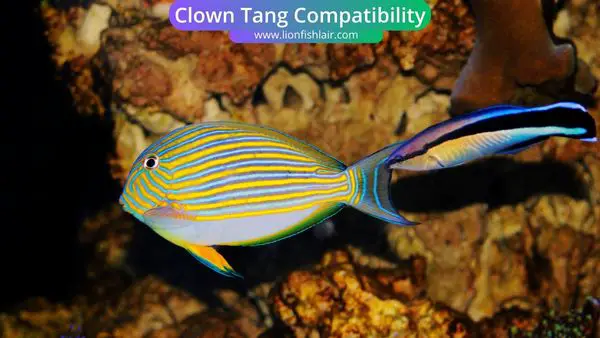
Clown tangs usually thrive in community environments, but should be matched with tank mates accordingly due to their size and aggression. Putting them in a tank environment with other tangs of a similar appearance is a big no-no, however, they will play well with other tangs of a different size and appearance. Here are some good options:
- Purple tangs
- Yellow tangs
- Tomini tangs
As mentioned, if you keep them in a reef tank with tons of good hiding spots, they will thrive being housed with other fish, as well as the other tang species' mentioned above. So, here are some of the best tank mates you can keep them with:

- Dwarf angelfish such as pygmy, flame, yellow to name a few.
- Chromisfish - these schooling fish are always a brilliat option for reef community environments.
- Various different gobies.
- Reef safe wrasses are also good options.
- You can keep them with clownfish, but just make sure you have enough cover and perhaps even an anemone for their protection.
Breeding
In the wild, clown tangs are egg-scattering fish that will typically form a pair fairly easily in the wild. However, it is not advised to even attempt to breed them in captivity unless you are an expert in breeding large tropical saltwater fish species. This is due to their aggressive nature towards their own kind and singlularity.
Clown Tang Food and Diet
When it comes to feeding them and what food they eat it is important to understand that they do require a special diet and have certain requirements. They will spend most of their days nibbling at the seabed and also on rocks, they will also graze on algae, seaweeds, diatoms, detritus, and filamentous algae too.
Diet and Recommended Food
They accept a mix of frozen, live, and algae-based foods, needing a varied diet in order to stave off any of the diseases they are susceptible too. This means that mixing in vegetable-based foods with live, frozen, and flake foods is essential. They are, however, extremely quick eaters, so you must ensure that the whole tank is being fed, and not just the Tangs. Additionally adding meats into their diet every now and then is certainly requried, bloodworms and shrimp are good options.
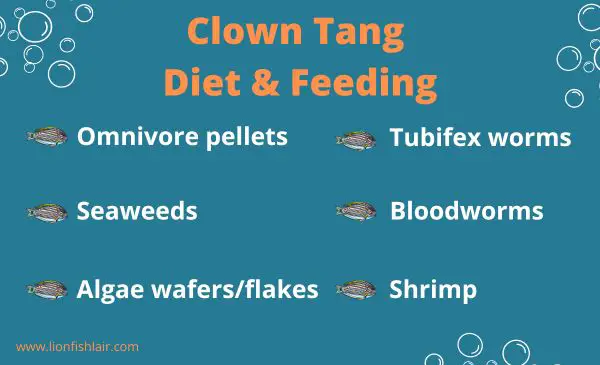
How Often Should you Feed a Clown Tang?
You should start off by feeding your clown tang twice a day, feed a generous portion at the start and gauge how much they are eating. If they tend to leave food then you are probably feeding them too much, reduce the amount down until you have found the perfect amount to feed your clown tang.
Obviously, as your clown tang grows older, wiser, and most importantly, bigger, they will need more food and a more varied diet to keep them healthy and on their toes, not literally though!
Conclusion
Clown tang surgeonfish are beautiful fish to watch majestically move around and do their thing, they are certainly not for beginners as they require a lot of work and a massive tank, but when you house a healthy and happy clown tang there is no better feeling! Their aggressive nature makes it harder to find compatible tank mates, but when you do find the right one, like the purple tang, you will be able to whitness a completely relaxed and awesome fish.
